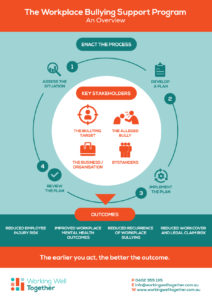Employers are commonly told that a key, if not the first, response to a bullying complaint is to implement an investigation. While I agree an investigation, formal or informal, is essential, there is a vital first step required for risk management. That is ensuring your employee is kept safe from mental health injury and further harm with appropriate workplace support.
If you don’t, you may be placing your employee at greater risk of psychological injury and breaching your health and safety obligations.
John’s Story
To demonstrate, I am going to share one employee’s story. Note that this story contains references to suicide ideation.
John (not his real name) was a middle manager. He was working within an office with a peer at an equal level. The peer would regular undermine him in their office environment along with using other abrasive office based behaviours. His sick leave increased. He was distressed, ranging between teary and crying. He crumpled and broke down under his workplace experience.
Feeling he had no other option, he lodged a formal complaint with his employer who instigated a formal investigation via an external investigator.
The employer passively suggested he contact Employee Assistance Program (EAP), which he didn’t do. He didn’t have any relationship with them and little faith in EAP after hearing other employees feedback on the service.
However, little did the employer or the investigator know throughout the investigation, he was having suicidal thoughts. In fact, this was to the point that he acted, which the employer was equally unaware of.
At no point in time did the company he work for assess the level, or risk, of injury he might have experienced.
Workplace bullying = serious risk of injury
There is enough research from over the last thirty years that gives us an understanding that bullying can result in serious psychological injury. For some this may be anxiety and stress which may lead to physical symptoms.
At the most serious end, workplace bullying has been linked to targets being twice as likely to consider suicide as non-bullied counterparts. Other research has indicated 57% of targets are likely to be suffering symptoms of post traumatic stress disorder.
Support first, then investigate
The first thing you need to do when you are faced with a workplace bullying complaint is provide support to the targeted employee. If you don’t, you are potentially placing your employee at further risk of injury and harm.
My experience in the field suggests merely advising an employee to contact EAP is an inadequate response given the alarming figures indicated by the research.
Risk management demands active responses to facilitating support when it comes to bullying. Some employees may push back. Others may not. Companies need to become better skilled at facilitating support and rolling with resistance to create linkages to appropriate support.
How do you facilitate support?
In the provision of our Workplace Bullying Support Program, I have found approaches that can assist link an employee to appropriate support.
Creating a connection between support worker and the target is essential to build trust before starting that support. A bullied employee will often feel they have lost power. This gives them back some of that lost power and control before proceeding with that support.
Explaining the purpose of the support is to keep them safe and return them to health and how the support works. This means that they understand what’s involved before hand. Once again, providing them with a level of control, knowledge and choice.
A confidential space in which they can share significant personal information creates an understanding of some of the challenges from that employees perspective. It allows for better solutions for that individual employee who should be placed at the centre of this process.
The confidentiality helps build trust which has usually been lost in a workplace bullying situation. With this in mind, external support is recommended because, as can be the target’s perspective, you as the employer have allowed this situation to occur. They have usually lost trust in their employer.
Assess the level and/or risk of injury
Finally, if you investigate the bullying complaint without assessing the level of, or injury risk, then you are potentially in breach of your health and safety obligations.
Australian health and safety laws expect that an employer does not place employees at risk in completion of their workplace responsibilities. A bullying complaint investigation, without appropriate support, can place the employee at further risk.
Providing support to bullied employees during a complaint is not optional. It is an essential if you are going to keep your employee safe or minimise harm; and manage the business risk effectively.
Are you curious to learn more about our approach to workplace bullying support?
Contact us today for a confidential discussion on how we can help you support your employees with bullying claims.
If you or anyone you know needs help:
- Lifeline on 13 11 14
- Kids Helpline on 1800 551 800
- MensLine Australia on 1300 789 978
- Suicide Call Back Service on 1300 659 467
- Beyond Blue on 1300 22 46 36
- Headspace on 1800 650 890
- ReachOut at au.reachout.com


